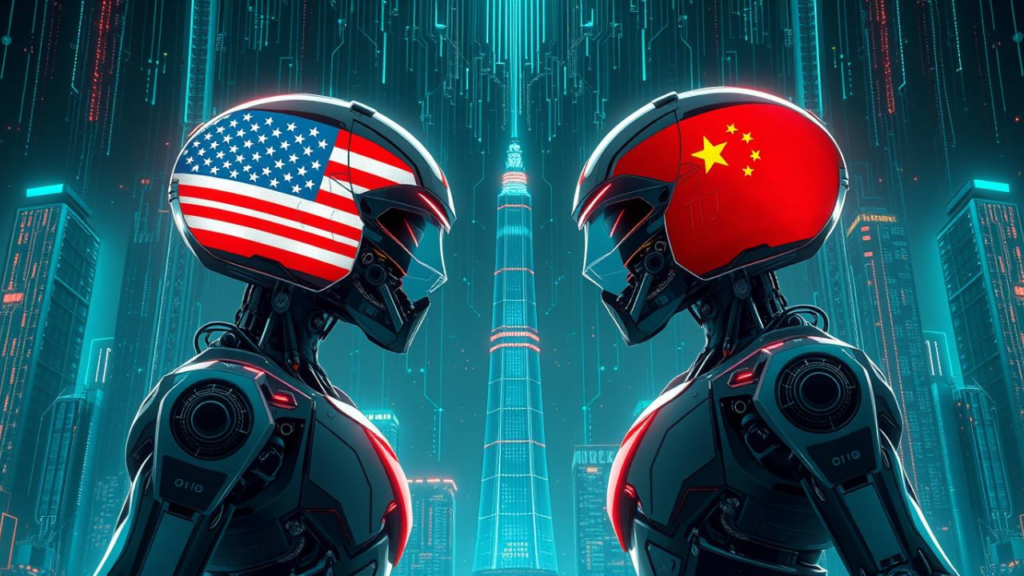This article delves into the ongoing U.S.-China competition in artificial intelligence, featuring insights from Alexandr Wang, CEO of Scale AI, on the evolving AI landscape, the rise of open-source models, and the future of AI capabilities

In the world of artificial intelligence (AI), one of the most significant and closely watched rivalries is the intense competition between the United States and China. The battle for supremacy in AI is not only a matter of technological advancement but also a geopolitical struggle with global ramifications. Alexandr Wang, the CEO of Scale AI, a leading company that specializes in providing labeled data to help companies train AI models, recently discussed this fierce competition in a conversation that sheds light on the evolving landscape of AI.
U.S.-China AI Rivalry: A Battle of Innovation
The U.S.-China AI race is crucial because the outcomes will shape the future of technology, economy, and global power dynamics. Wang emphasized the critical nature of this rivalry, pointing out that the Chinese AI lab DeepMind’s models are getting dangerously close to matching or even surpassing the best AI models produced by American companies. Despite the challenges China faces, such as limited access to high-end computing chips like Nvidia’s A100, the nation’s AI capabilities have been rapidly advancing.
China’s AI research and development have witnessed significant strides, especially in areas like language processing, reasoning, and code generation. However, the country is not without its limitations. The restricted access to top-tier hardware, especially chips from leading American companies like Nvidia, has been a stumbling block. These chips are essential for training the largest and most powerful AI models, which rely on vast computational resources. Still, Wang highlighted that China’s AI models are overcoming such challenges through innovative solutions and a commitment to advancement.
The Increasing Role of Open-Source AI Models
As the competition between U.S. and Chinese companies intensifies, the landscape of AI innovation is also evolving. Open-source models and tools have become increasingly popular, offering businesses and developers cost-effective alternatives to premium offerings from major companies like OpenAI and Anthropic. Open-source models are now being seen as viable options for many AI applications, particularly for use cases that do not require the most advanced capabilities.
This shift toward open-source AI is partly driven by the high costs associated with training and running cutting-edge models from major players. Businesses are looking for ways to minimize expenses while still leveraging AI to improve their products and services. Open-source AI offers a compelling solution, enabling companies to deploy AI technologies without the massive financial commitment that typically accompanies the use of proprietary models.
Wang’s observations on the rise of open-source models align with broader trends in the tech industry. As AI becomes more democratized, these open-source tools are expected to become more sophisticated, giving rise to a diverse range of AI applications. This democratization will likely lead to greater accessibility and innovation across industries, as smaller companies and developers gain the ability to experiment with and implement advanced AI technologies.
Data Generation and the Future of AI
Despite the progress made in AI development, Wang stressed that ongoing innovation in data generation is essential for the continued evolution of AI models. AI models require vast amounts of labeled data to be trained effectively, and the availability and quality of this data are critical to their success. As AI evolves, the complexity of the models will increase, leading to more advanced capabilities. However, these advanced models will likely come with a higher price tag, limiting their accessibility to only the most well-funded organizations.
For businesses looking for more straightforward AI applications, Wang predicts that open-source models will become an attractive solution. These models, while not as advanced as the latest proprietary offerings, will provide cost-effective solutions for simpler use cases like customer service, chatbots, and language translation. For more complex tasks such as reasoning, coding, and multilingual AI capabilities, companies will likely continue to rely on premium, high-performance models that require substantial resources.
As the AI landscape continues to evolve, businesses and developers must navigate a rapidly changing environment, balancing the need for cutting-edge technology with the constraints of budget and resources. The future of AI, according to Wang, will likely feature a hybrid model, with advanced proprietary models serving high-demand applications and open-source models catering to less complex but still impactful use cases.
Conclusion: Embracing Innovation in a Competitive World
The AI race between the U.S. and China is far from over, and both nations are making remarkable strides in the development of artificial intelligence technologies. As Alexandr Wang highlighted, the competition is not just about technological supremacy but also about shaping the future of global power. In this race, the rise of open-source AI models offers new opportunities for innovation, providing businesses with the tools they need to harness the power of artificial intelligence in more cost-effective ways.
Ultimately, the ongoing advancements in AI technology will continue to redefine industries, economies, and societies worldwide. As AI capabilities grow more advanced and diverse, the key to success will lie in a balanced approach—leveraging cutting-edge models for complex tasks while also embracing open-source alternatives for more accessible applications. Whether through the fierce U.S.-China rivalry or the growing popularity of open-source AI, the future of artificial intelligence promises to be one of rapid innovation and transformation.


